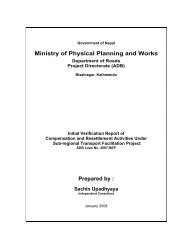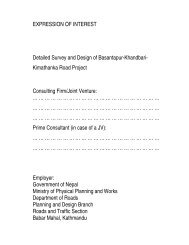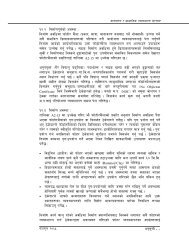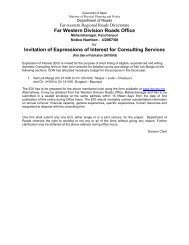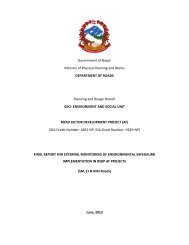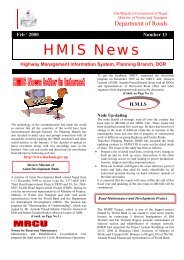Environmental & Social Management Framework - About ...
Environmental & Social Management Framework - About ...
Environmental & Social Management Framework - About ...
You also want an ePaper? Increase the reach of your titles
YUMPU automatically turns print PDFs into web optimized ePapers that Google loves.
<strong>Environmental</strong> and <strong>Social</strong> <strong>Management</strong> <strong>Framework</strong>An increase in commercial activities like general shops, lodges, hotels, liquorshops, as a consequence of opening new road links may lead to the increase (orin some cases decrease) in land values (adjoining and others). Operation ofroads may bring about changes in the agricultural practices, productivity, cropvariety,etc. and land-uses (increase in built-up areas, decrease in agriculturalareas, forest areas, etc.), farmers' livelihood and may also encourage tourism.The induced changes are not necessarily limited to the immediate vicinity of theroad route. Both positive and negative social and environmental consequencesare possible from such changes. After construction of road and better access, asituation may develop in which the value of land in a particular area is increased(as discussed above, Ch. 4.2.3), leading to higher rental value, a turnover inoccupancy, and a replacement of lower income tenants and residents by thosewho can afford the higher rents (often migrants and/or outsiders). This process,known as gentrification, is mainly a distributional issue, recognizing that a roaddevelopment project can harm the weaker segments of the community whilefavouring the wealthier ones.The government's right to expropriate carries with it a responsibility to ensure thatthose affected do not bear an unfair share of the costs of a project which willbring benefits to others. In the simplest terms, this responsibility should be toensure that the standard of living of all affected persons is restored to the levelenjoyed before the commencement of the road project. Depending on how wellthe resettlement is planned, it may go a long way in compensating for the lossand disruption, or it may exacerbate the suffering. More details on resettlement,compensation and eligibility are presented in Chapter 7 of this document. Incases where local settlements are affected in road upgrading projects, thespecific IEEs/EIAs under the forthcoming SRN Program make due reference onhow to solve locally the problems of relocating and compensating privatestructures and business (particularly in locations where the upgrading workshappen in rural market areas, like in sections of the studied roads in Satbanj-Jhulaghat, Khodpe-Jhota and Chinchu-Chegegad).The economic impacts of expropriation may include the loss of houses orbusinesses, or the loss of business income, either temporary or permanent. Thesocial and psychological impacts and associated costs are more complex, andthey are often much more devastating. Business people may find theirestablished clientele cut off from their shops or experience changes in businesspractices they neither anticipate nor like. These kinds of social and economicchanges often find personal expression in a variety of physical or psychologicaldisorders.The existence or new establishments of squatters on the right-of-way poseparticular challenges for road and land-use manager. There are many reasonswhy the poor, the homeless, those pursuing informal economic activities, andsmall-scale farmers encroach upon the publicly owned right-of-way and, in manycases, the existing road surface. More often than not, road projects tend todisplace these persons whose very presence signifies their need for specialattention. Legally, projects often recognize only formal registered titles. The resultis commonly impacting the road structure, and impedes proper maintenanceoperations. Among the most frequent encroachment observable in rural settingsof Nepal are:• Selling of goods, whether from individual kiosks or more expansive markets;• Small business such as cafes and vehicle repair shops;• Uncontrolled stops by buses, taxis, and informal public transport;• Unregulated parking, often related associated with business activities;• Production of bricks on the road surface; and• Growing of crops and drying of farm produce within the road reserve.April 2007 Chapter 4-21



![j:6 ]zg cfof ]hgf](https://img.yumpu.com/51286794/1/190x245/j6-zg-cfof-hgf.jpg?quality=85)

![x'nfsL /fhdfu { cfof ]hgf](https://img.yumpu.com/50581959/1/190x245/xnfsl-fhdfu-cfof-hgf.jpg?quality=85)
